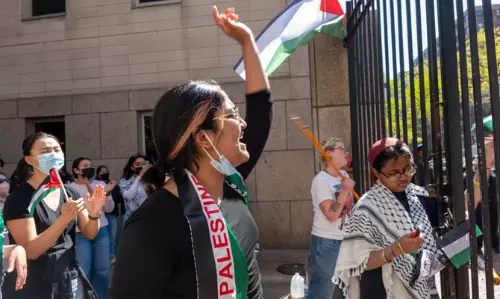
A testimony of Russia's composite culture
text_fieldsMoscow: The layout of the famous Red Square here, with the 16th century cathedral of St. Vasily's on one corner, evokes different epochs of Russia's history, bringing alive images in the mind of an Indian visitor the way different eras coexist back home.
The red walls of the Kremlin Palace that close off one side of the massive stone-paved square loom over Lenin's mausoleum cast in the same colour, while the onion-shaped domes of the cathedral in many colours rise like flames of a bonfire going up in the sky.
 Currently a state-run museum, Vasily's (Basil) church, or the series of churches grouped around a central one, acquired its modern-day vivid colours over a period from the late 17th to the 19th centuries. The cathedral foreshadows the climax of Russian architecture in the 17th century, and testifying to its unique design, historian Dmitry Shvidkovsky writes in "Russian Architecture and the West" that "it is like no other Russian building".
Currently a state-run museum, Vasily's (Basil) church, or the series of churches grouped around a central one, acquired its modern-day vivid colours over a period from the late 17th to the 19th centuries. The cathedral foreshadows the climax of Russian architecture in the 17th century, and testifying to its unique design, historian Dmitry Shvidkovsky writes in "Russian Architecture and the West" that "it is like no other Russian building".
"Nothing similar can be found in the entire millennium of Byzantine tradition from the fifth to fifteenth century," Shvidkovsky writes of this complex of churches erected during 1555-61 to mark Tsar Ivan IV's victories in the conquest of the Tatar capital, Kazan.
Tsar Ivan IV marked every victory of the Russo-Kazan War by erecting a wooden memorial church next to the walls of the existing Trinity Church. By the end of his capture of Kazan and Astrakhan, the central church was shrouded within a cluster of seven wooden churches.
Going forward in time, Tatarstan today is a federal consituent of the Russian Federation, is one of the most developed regions of the country and is home to its largest Muslim population. Followers of Sunni Islam constitute the majority in Tatarstan.
It also produces 32 million tonnes of crude oil per year and has estimated reserves of more than one billion tonnes. Industrial production constitutes 45 percent of Russia's gross regional domestic product.
Going backwards in time to the Tatar ethnicity also takes us to its links with India.
When Ivan conquered Kazan, he brought down the Khanate that had followed the breakup of the Golden Horde of Genghis Khan. Volga Bulgaria, which preceded the Kazan Khanate was the first Muslim state within the boundaries of modern Russia, when the rulers converted to Islam early in the 10th century.
 Volga Bulgaria fell to the Mongol prince Batu Khan in the late 1230s, while the inhabitants, mixing with the Golden Horde's Kipchak-speaking people, became known as the Volga Tatars.
Volga Bulgaria fell to the Mongol prince Batu Khan in the late 1230s, while the inhabitants, mixing with the Golden Horde's Kipchak-speaking people, became known as the Volga Tatars.
The Golden Horde was a Mongol and later Turkicized khanate, established in the 13th century, which comprised the northwestern sector of the Mongol Empire. It was invaded in 1396 by Tamerlane, who also led the Mongol army in an invasion of north India in 1398, while the later journey of the Turkicised Mongols to India to found the Mughal Empire is history.
The breaking away of Central Asian Republics at the dissolution of the USSR in the early 1990s is cited as a failure of the Soviet state in resolving the nationalities question, to which the Indian model has shown to have found a more durable solution.
As this correspondent gazed at the blue, white, red and gold exteriors of St. Vasily's on the Red Square under the bright June sun, Russia is in the middle of a conflict with Ukraine involving its Russian-speaking population - thankfully a situation we in India have not had to face.

















